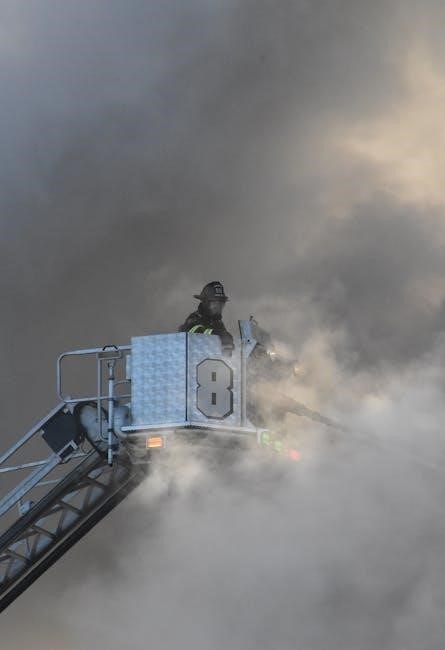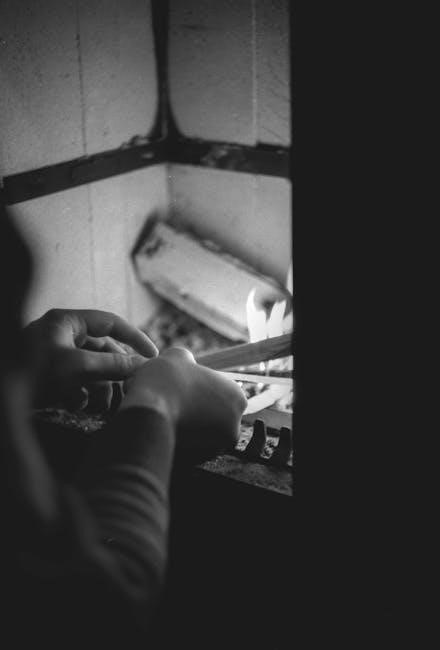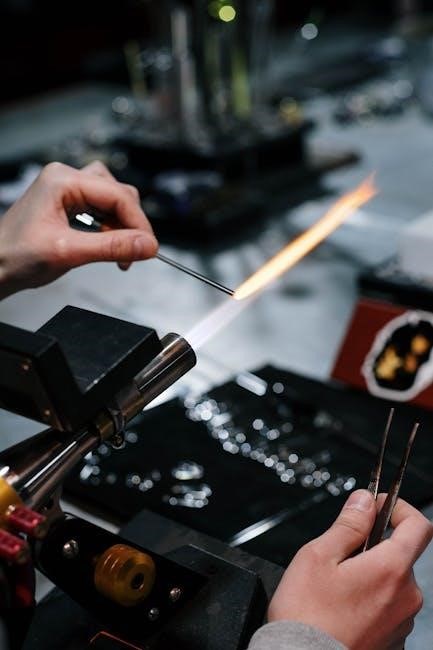
firex fire alarm manual
The Firex Fire Alarm Manual provides essential guidance for installing, maintaining, and using Firex smoke alarms, ensuring safety and compliance with fire protection standards. Follow instructions carefully.
1.1 Overview of Firex Smoke Alarms
Firex smoke alarms are reliable devices designed to detect smoke and provide early fire warnings. Models like FADC230 offer ionization technology, battery backup, and false alarm control. These alarms are known for their durability and compliance with safety standards, ensuring effective fire detection in residential settings. Proper installation and maintenance are key to their performance, as outlined in the manual.
1.2 Importance of Proper Installation and Maintenance
Proper installation and maintenance of Firex smoke alarms are crucial for ensuring reliable fire detection. Incorrect placement or failure to test and clean can reduce effectiveness. Following the manual’s guidelines ensures optimal performance, minimizing false alarms and prolonging device lifespan. Regular testing and battery checks are essential to maintain functionality and safety standards, as emphasized in the manual.
Understanding Firex Smoke Alarm Components
Firex smoke alarms consist of sensors, alarms, and power sources. Ionization and photoelectric models detect smoke differently, ensuring reliable fire detection. Key features include battery backup, false alarm control, and test buttons for functionality checks, as outlined in the manual.
2.1 Types of Smoke Alarms (Ionization, Photoelectric)
Firex smoke alarms are available in two primary types: ionization and photoelectric. Ionization alarms detect minute fire particles, ideal for flaming fires, while photoelectric alarms identify larger smoke particles, better for smoldering fires. Both types ensure early detection, reducing false alarms in specific scenarios. Understanding their differences aids in selecting the most suitable alarm for varying fire risks and conditions, enhancing home safety.
2.2 Key Features of Firex Smoke Alarms (Battery Backup, False Alarm Control)
Firex smoke alarms feature battery backup for continuous operation during power outages and false alarm control to minimize unnecessary alerts. These features enhance reliability and user confidence, ensuring alarms function when needed while reducing disruptions from non-emergency situations, making them a reliable choice for home fire safety and compliance with safety standards.
Installation Guidelines
Proper installation ensures optimal performance and safety. Follow manual instructions for locating, mounting, and wiring smoke alarms to meet fire safety standards and regulations effectively.
3.1 Choosing the Right Location for Smoke Alarms
Install smoke alarms in every sleeping area and outside each bedroom, ensuring coverage across all levels of your home. Avoid areas near kitchens or bathrooms to minimize false alarms caused by cooking smoke or steam. Optimal placement on ceilings or walls, at least 10 feet from cooking appliances, ensures reliable detection and reduces nuisance triggers effectively.
3.2 Step-by-Step Installation Process
Begin by selecting a suitable location, ensuring compliance with safety guidelines. Mount the bracket securely to the ceiling or wall, then attach the smoke alarm. For hardwired models, connect the wires to the home’s electrical system. Install the battery, ensuring proper polarity. Test the alarm using the test button to confirm functionality. Finally, clean the alarm to ensure optimal performance and sensitivity.
3.3 Wiring and Interconnection of Smoke Alarms
Ensure all wiring is done by a licensed electrician for hardwired models. Use 120V AC power and maintain proper connections to avoid malfunctions. For interconnection, link alarms in a series circuit to ensure synchronized operation. Test the system after installation to confirm all units activate simultaneously. Follow the manual’s wiring diagram for accuracy and safety. Never mix smoke alarm models in an interconnected system, and avoid damaged or frayed wires for reliable performance.
Maintenance and Testing
Regularly test smoke alarms monthly and clean dust from sensors to ensure proper operation. Replace batteries annually or as indicated to maintain reliability and safety. Follow manual instructions.
4.1 Regular Testing of Smoke Alarms
Testing smoke alarms monthly is crucial for ensuring reliability. Press the test button to verify the alarm sounds and check battery levels. For hardwired systems, ensure power is consistent. Clean dust from sensors to prevent false alarms. Follow the Firex manual’s guidelines for testing procedures to maintain optimal performance and safety standards always. Regular testing ensures early fire detection, saving lives and property. Comply with manufacturer recommendations to avoid potential hazards and failures. Consistency in testing routines helps prevent overlooked issues, ensuring your home remains protected at all times. Proper maintenance and testing are key to reliable smoke alarm functionality. Always adhere to the Firex manual’s instructions for comprehensive safety coverage.
4.2 Cleaning and Servicing the Alarm
Regular cleaning of Firex smoke alarms is essential for optimal performance. Use a soft brush or vacuum cleaner to remove dust and debris from sensors and vents. Avoid using chemicals or paint, as they can damage components. Servicing should be done every six months to ensure sensors function correctly. Replace batteries annually or as specified in the manual; Cleaning prevents false alarms caused by dirt buildup. Always follow Firex guidelines for servicing to maintain reliability. Proper maintenance ensures smoke alarms detect fires accurately, providing crucial early warnings. Consistent servicing extends the life of your Firex smoke alarms, safeguarding your home and family. Regular cleaning and servicing are vital for maintaining fire safety standards. By adhering to these steps, you ensure your alarms remain in peak condition. Always refer to the Firex manual for detailed instructions on cleaning and servicing procedures. Keep your smoke alarms free from contaminants to ensure they work when needed most. This routine maintenance is a simple yet critical step in home fire safety. Firex smoke alarms require minimal upkeep but demand consistency to function effectively. Stay proactive with cleaning and servicing to protect your property and loved ones. Remember, a well-maintained smoke alarm is your first line of defense against fire hazards.

Troubleshooting Common Issues
Identify and resolve common issues like false alarms, power outages, or connectivity problems. Check connections, test functionality, and ensure proper installation to maintain optimal performance and safety.
5.1 Recognizing and Addressing False Alarms
False alarms occur due to dust, steam, or cooking fumes. To address, clean the alarm with a vacuum or damp cloth. Relocate alarms away from kitchens or bathrooms. Use Firex’s False Alarm Control feature to minimize interruptions. Avoid disabling the alarm, as it compromises safety. Regular testing ensures proper functionality and reduces unnecessary alerts. Always follow the manual’s troubleshooting guide for resolving recurring issues effectively.
5.2 Resolving Power and Connectivity Problems
Check the power source for mains-powered alarms. Ensure connections are secure and not damaged. For battery-powered models, replace batteries if the alarm chirps. Test the alarm after addressing power issues. If interconnected, verify wiring between units. Consult the manual or contact support for persistent connectivity problems. Regularly inspect wires and connections to prevent future issues and ensure reliable operation of your Firex smoke alarm system.

Interconnecting Smoke Alarms
Interconnecting smoke alarms ensures all units sound an alarm when one detects smoke, providing early warning throughout the building. This setup enhances fire safety and response efficiency.
6.1 Benefits of Interconnected Smoke Alarms
Interconnected smoke alarms offer enhanced safety by ensuring all units activate simultaneously upon detection, providing consistent alerts throughout the building. This unified response reduces reaction time, improves evacuation efficiency, and minimizes potential risks during a fire emergency. Additionally, interconnected systems streamline testing and maintenance, ensuring all alarms function correctly and reliably.
6.2 Setup and Configuration for Interconnected Systems
Configuring interconnected Firex smoke alarms involves linking each unit to ensure simultaneous activation. Start by connecting the alarms using compatible wiring, typically 18 AWG or lower, and follow the manufacturer’s guidelines for circuit requirements. Ensure all units are powered and test the interconnection by triggering one alarm to verify all activate. Regularly inspect wiring for damage or wear to maintain reliability and safety.

Safety Guidelines and Precautions
Always follow the Firex fire alarm manual instructions to ensure proper installation and maintenance. Never disable or remove smoke alarms, as this compromises home safety and fire detection.
7.1 Do’s and Don’ts for Smoke Alarm Usage
Do install smoke alarms in every sleeping area and outside each bedroom. Test alarms monthly and replace batteries annually. Don’t paint or cover alarms, and avoid installing near vents. Keep alarms out of children’s reach. Ensure compliance with NFPA standards and local codes for optimal fire safety and early detection capabilities in your home.
7.2 Emergency Procedures During a Fire
Stay calm and follow your escape plan. Keep low to avoid smoke inhalation. Never use elevators; exit via the safest route. Close doors to contain the fire. Evacuate immediately and meet at a designated safe spot. Do not re-enter until fire officials confirm it’s safe. Call emergency services if needed; Always prioritize safety and ensure alarms are functioning to alert everyone effectively during emergencies.
Replacing Firex Smoke Alarms
Replacing Firex smoke alarms is crucial for maintaining fire safety. Replace units when expired, damaged, or outdated. Always use a licensed electrician and a comparable Firex model to ensure reliability and compliance with safety standards.
8.1 When to Replace the Smoke Alarm
Replace Firex smoke alarms every 10 years or sooner if damaged, faulty, or showing signs of wear. Replace immediately if the alarm malfunctions, has false alarms, or after a fire incident. Ensure timely replacement to maintain optimal safety and reliability, adhering to manufacturer guidelines and local fire safety regulations for proper functionality and protection.
8.2 Steps to Replace a Firex Smoke Alarm
To replace a Firex smoke alarm, first, turn off the power supply and disconnect the alarm from the wiring. Remove the old unit and attach the new one, ensuring proper wiring connections. Test the alarm to confirm it works. Replace every 10 years or as needed, following the manual’s instructions for a safe and correct installation, ensuring reliable fire detection and compliance with safety standards.
Compliance and Regulations
Firex smoke alarms must comply with National Fire Protection Association (NFPA) standards and local building codes. Always follow manual instructions to ensure safety and regulatory adherence.
9.1 National Fire Protection Association (NFPA) Standards
NFPA standards dictate installation, testing, and maintenance of smoke alarms. Firex alarms must meet these requirements to ensure reliability and safety. Compliance ensures effective fire detection and warning systems.
9.2 Local Building Codes and Requirements
Local building codes specify smoke alarm requirements, including placement, type, and interconnection. Firex alarms must comply with these regulations to meet regional safety standards and ensure proper function in various residential settings. Compliance is mandatory for safety and legal adherence.

Additional Resources
Firex provides user manuals, guides, and online support for smoke alarm installation, maintenance, and troubleshooting. Access downloadable PDF manuals and additional resources for comprehensive assistance.
10.1 Firex User Manuals and Guides
Firex smoke alarm manuals are available online as downloadable PDFs, offering detailed installation, maintenance, and troubleshooting instructions. The Firex A User Manual, for example, provides a 12-page comprehensive guide. These resources ensure proper setup and operation, covering topics like false alarm control and battery replacement. They also emphasize compliance with safety standards, ensuring your system functions reliably during emergencies. Always refer to these guides for accurate information and safe usage.
10.2 Online Support and Troubleshooting
Firex offers extensive online support, including troubleshooting guides and downloadable resources. Visit the official Firex website for access to user manuals, FAQs, and interactive tools. The Firex A User Manual and other guides provide step-by-step solutions for common issues. Additionally, 24/7 customer support is available for technical assistance. Utilize these resources to resolve problems efficiently and ensure your smoke alarm system operates correctly and safely.